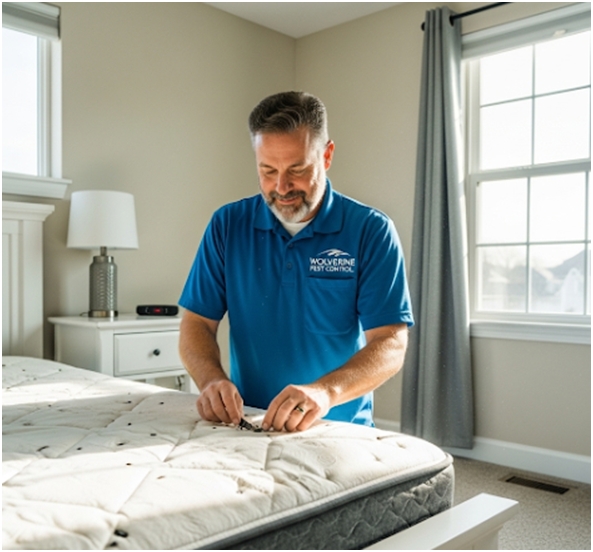Essential Bed Bug Facts for Prevention & Control

Bed Bugs & Travel: Tips to Stay Safe
Planning a getaway or visiting family over the holidays? With bed bugs now more widespread than ever, it’s important to take precautions whether you’re staying at a five-star resort, a cruise ship, or a roadside motel. one out of five Americans has either dealt with bed bugs or knows someone who has—and travel is a major way these pests spread. Travel Safe: Bed Bug Tips, we believe that knowledge is your best defense against bed bugs. Call (517)-999-5008
Before settling into your room:
- Place your luggage in the bathroom, away from soft furnishings.
- Carefully inspect bedding, mattresses, box springs, bed skirts, side tables, and even inside drawers and alarm clocks for signs of bugs or tiny brown/red stains (bed bug droppings).
- Use a small flashlight to check dark corners, behind headboards, and around baseboards and molding.
- Look for shed skins, tiny white eggs, or a sweet, musty odor—all potential bed bug clues.
If you spot any signs—or even if a room smells suspiciously unclean—ask for a new room far from the original. Bed bugs can quickly spread from one room to another.
Why Are Bed Bugs Increasing?
Recent reports show that bed bug activity is rising worldwide; for example, PestWorld noted a 66% increase in 2023 alone. Here’s why:
- Pesticide Resistance: Overuse of traditional treatments has led to stronger, more resistant bed bugs.
- Return to Travel: As travel rebounds post-pandemic, so do bed bug encounters. These pests can survive long periods without feeding and are eager to hitch a ride once people start moving again.
- Misinformation: Myths such as “bed bugs only live in beds” help the pests spread unchecked. Bed bugs can thrive in furniture, luggage, clothes, public spaces—just about anywhere people go.
How to Protect Yourself During Travel
- Luggage: Hard-shell suitcases are less hospitable for bed bugs than soft luggage. Wipe down your bags regularly, and after trips, inspect and vacuum your luggage.
- On-the-Go Checks: Bed bugs can be anywhere—planes, trains, buses, cruise cabins. After excursions, check your belongings before bringing them back into your room.
Laundry: Use the hotel’s dryer (at high heat) to kill any potential stowaways on your clothes.
Dependable Residential Pest Control
Call for a FREE quote over the phone! (517) 999-5008
Think You Found Bed Bugs? Here’s What to Do:
8 Essential Post-Travel Luggage Tips
Important Things Your Exterminator Won’t Tell You No one looks forward to unpacking after a fun trip, but acting quickly with your luggage can prevent unwanted pests from coming home with you. Every time you return from traveling, follow these eight simple steps to ensure the only things you bring back are memories and souvenirs:
- Unpack Immediately: Don’t let your suitcase sit in your bedroom. Unpack as soon as you get home, ideally in a garage, mudroom, or bathroom.
- Inspect Your Luggage: Carefully check seams, pockets, and zippers for any signs of bugs—especially bed bugs or their eggs.
- Wash Clothes Right Away: Launder all clothing, whether worn or not, in hot water and dry on high heat to kill any hitchhikers.
- Vacuum Your Suitcase: Use a vacuum to clean inside and outside your luggage, paying close attention to seams and pockets.
- Wipe Down Hard Surfaces: Hard-shell luggage can be wiped with a cloth and a suitable cleaner to remove any lingering pests.
- Store Luggage Properly: After inspection and cleaning, store your luggage in a dry area away from sleeping spaces—ideally in a basement or garage.
- Check Souvenirs: Inspect any newly acquired items, especially textiles, before bringing them into your home.
Monitor for Signs: Over the next couple of weeks, keep an eye out for unexplained bites or any signs of bed bugs in your bedroom. Bed bugs can multiply rapidly and are tough to eliminate without expert help. Early detection is key to stress-free pest control—and helps avoid expensive, widespread bed bug infestations.
Bed Bugs vs. Ticks: Know the Difference
At first glance, ticks and bed bugs may look alike, but telling them apart is crucial given the different risks they pose. Here’s how to distinguish between these two pests:
- Appearance:
- Both are small, flat, and brownish, and both expand after a meal.
- Ticks are arachnids with 8 legs.
- Bed bugs are insects with 6 legs and a more oval, apple-seed shape.
- Habitat:
- Ticks are mostly found outdoors—in tall grass, brushy areas, or leaf piles. They latch onto animals and humans who wander by.
- Bed bugs are indoor pests, hitching rides into your home on luggage, furniture, or used clothing. They prefer to hide in beds, sofas, or linens close to where people sleep.
- Feeding & Hosts:
- Ticks feed on blood from humans, wildlife, and pets.
- Bed bugs feed exclusively on human blood, especially at night.
- Health Risks:
- Bed bug bites cause itching, redness, and irritation. Fortunately, they don’t spread diseases.
- Tick bites can transmit dangerous illnesses such as Lyme disease, Rocky Mountain spotted fever, and babesiosis.
- What to Do: Both pests are most active during the warmer months and can go unnoticed for a while. If you notice unexplained bites, find bugs in your home, or have any suspicion of an infestation, contact Wolverine Pest Control right away for expert inspection and treatment.
- Appearance:
At Wolverine Pest Control, we believe that knowledge is your best defense against bed bugs. Our expert-crafted blogs are packed with crucial information designed to protect your family, guests, or business from these unwanted invaders. Here, you’ll find reliable tips on how to spot bed bugs, where they commonly hide, and what to do if you think you have an infestation.
SERVING Eaton Rapids, MI Grand Rapids, MI Lansing, MI Jackson, MI Ann Arbor, MI Marshall, MI Howell, MI Charlotte, MI
And Surrounding Areas
